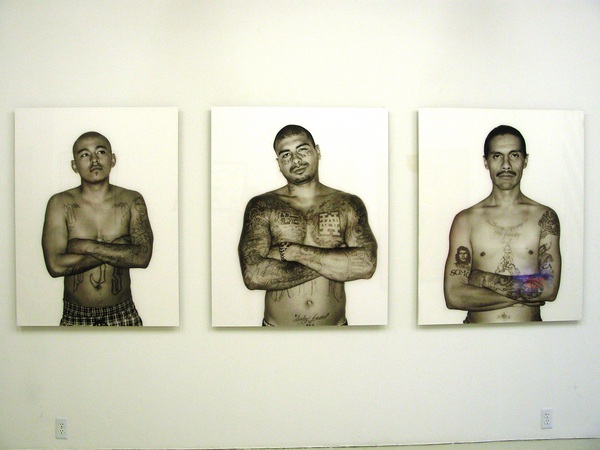This is an archive of the ArtCat Zine, 2007-2009. Please visit our new project, IDIOM.
Kathleen Cullen on "Tattoo"

Tattoo at Kathleen Cullen Fine Arts is a multimedia exploration of tattoo art and its ever-changing role in society. The exhibition includes paintings, photography, sculpture and film, as well as a few empty bottles of Jack Daniels littered about the gallery for an something like an authentic, tattoo parlor feel. We caught up with Cullen, the director of the gallery, and asked about her inspiration for the show and her take on tattoo art.-- S.K.
Stephanie Korszen for ArtCat: What was your inspiration for situating the work of tattoo artists within the context of a fine art gallery?
Kathleen Cullen: The inspiration is really the everyday. You need only sit down at a café or bar, or stand at a traffic light, to grant your eyes the opportunity to admire the body art on others' skin. Additionally, one of the artists I represent, Max Snow, served as the catalyst for this exhibition. In 2008, Max documented the stories of Latino gang members in L.A., for whom tattoo art serves an important role in self-identity. Max also wears part of his identity externally in the form of body art.
In the 1930s, Herbert Hoffmann photographed people and documented their fantastic stories before they were sent to prison by the Third Reich. He developed a great respect for these people, whom he saw as hard-working and unpretentious. Many bore the simplest of tattoos on their arms and hands – historically a sign of degeneracy. Over the years, tattoos have broken free of this inherent link to all things degenerate, to the point where they now have the potential to serve as a status symbol on par with designer handbags. Bruce Willis, on the cover of W Magazine, sports tattoos. Supermodels adorn themselves with body art. We see biker motifs, as well as Maori, Japanese, and sailor themes – rich codes to decipher on other’s bodies.
AC: You’ve discussed tattoo art as an intercession between the arenas of popular and high culture. How have you mirrored this comingling of cultures in your gallery space?
KC: We have everything from a Keith Haring poster, graffiti tattoos, tattoo-inspired furniture
and a film, Mark of Cain, by Alix Lambert. This film was part of a ten-year project during which the Lambert interviewed criminals in Russia. Lambert’s project inspired David Cronenberg to review the Russian criminal tattoo codes for the well-known movie Eastern Promises, starring Vigo Mortensen and Naomi Watts. Lambert reveals the hidden history behind Russian tattoos, as well as their complex symbolism.
AC: How did you conduct your research for this exhibition?
KC: We began by researching books and articles on the tattoo subculture from the 1930s
through the 1950s, and then followed the evolution of the tattoo further into the punk generation of the 1970s and 80s. Tattoos have transcended their stereotypical role as the mark of a lowlife in the first half of the twentieth century – though youthful sailors often flaunted tattoos as a rite of manhood – to arrive at a socially-accepted norm. Represented in our exhibit are biker, Maori, Japanese and sailor motifs.
Also included is Larry Clark's Tulsa tattoo. Like Danny Lyons, Clark blurred the lines between observer and participant. Lyons photographed unwanted, hated bikers. A common underlying theme for the artists represented in the exhibition is the desire to share an emotional closeness with their subjects. The resulting works are not merely documents; they are empathetic portraits.
AC: In presenting tattoo art, all of the works on display also portray the tattooed. Do you feel that the meaning of a tattoo is inherently tied to – and thus dependent upon – the individual’s identity?
KC: The meaning of a tattoo is intrinsically tied to a person's identity, because without the individual, the tattoo is rendered meaningless. If the individual was done away with, the tattoo would become an image devoid of significance.
ZINE
HOME
TIPS / COMMENTS
CATEGORIES
CONTRIBUTORS
- Greg Afinogenov
- B. Blagojevic
- Adda Birnir
- Susannah Edelbaum
- Julie Fishkin
- Paddy Johnson
- Jessica Loudis
- Christopher Reiger
- Andrew Robinson
- Peter J. Russo
- Blythe Sheldon
- S.C.Squibb
- Hrag Vartanian

